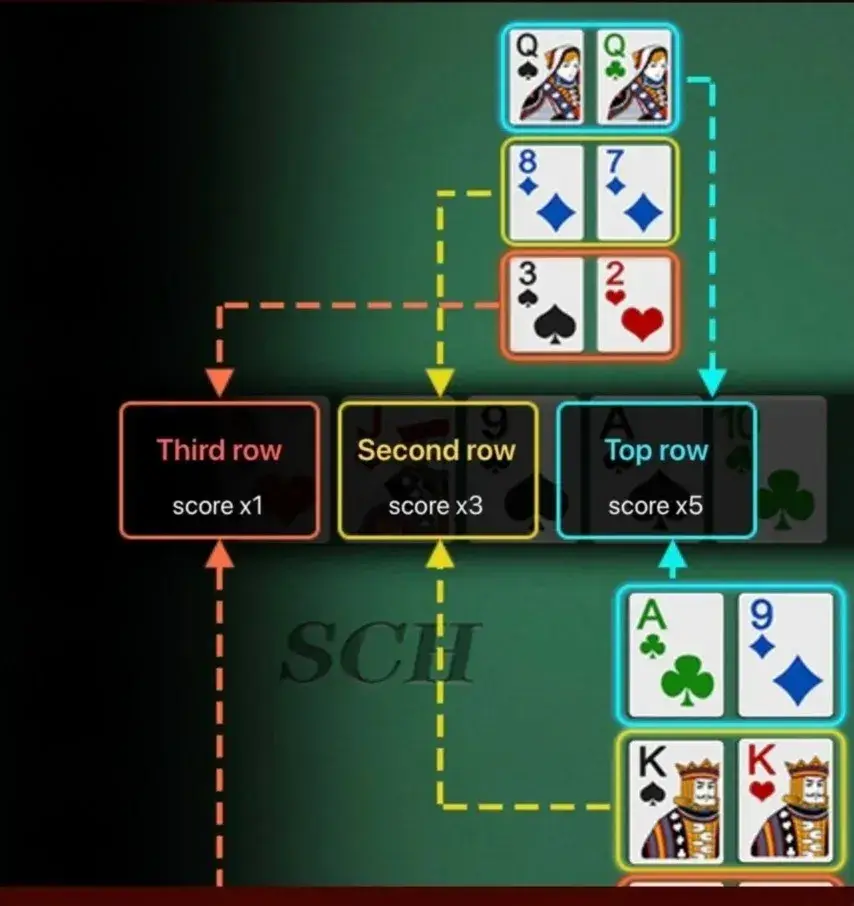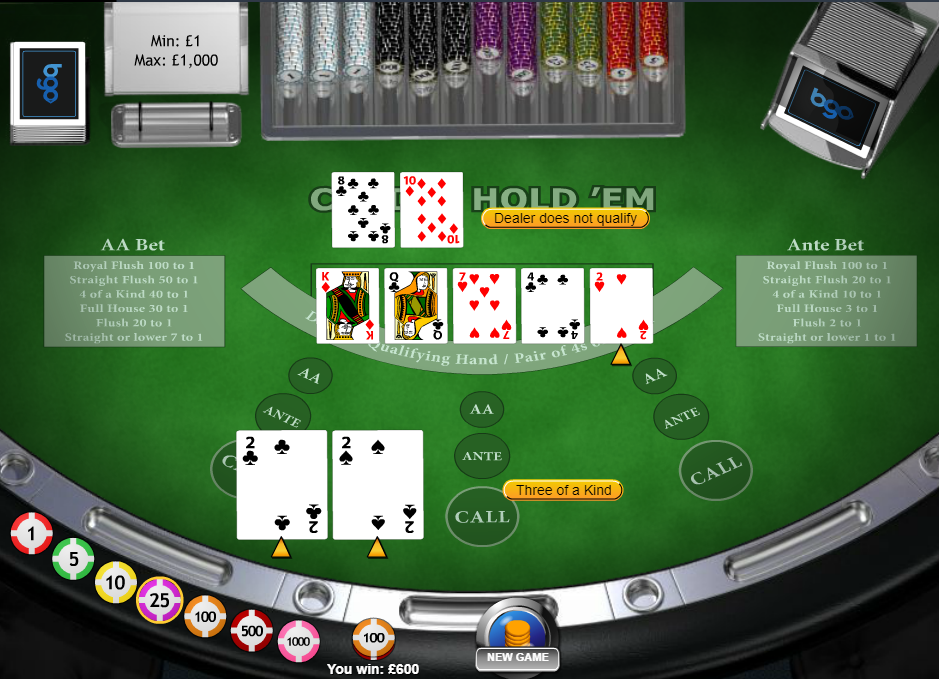Chinese poker stands out among card gambling games, offering a challenge even to Texas Hold’em masters. Unlike classical disciplines where bluffing is important, the emphasis here is on combination building and mathematical analysis. That’s why learning how to play Chinese poker is especially important in the age of online poker and the quest for intellectual superiority at virtual tables.
Chinese poker rules: how to play
Chinese poker, aka “Pineapple” is not a game of chance. Here all players have the same chances. Each round starts from scratch and becomes a new game of strategy and logic.
Deck: standard, 52 cards without jokers. Players: from 2 to 4. The main goal is to correctly arrange the 13 cards received into three poker combinations:

- front (3 cards) – the weakest part of the hand;
- middle (5 cards) – the combination of medium strength;
- back (5 cards) – the strongest row.
The main rule is to observe the hierarchy of strength of combinations. The back row should be stronger than the middle row, and the middle row should be stronger than the front. If you break this logic, you automatically lose the round (this is called a folded hand).
At this point, it is important to understand how to play Chinese poker. It all starts with proper hand placement: a mistake in positioning a strong combination can nullify even a potentially winning hand. Remember: strong cards are no guarantee of success if they are not in the right place.
Deal and Placement: A Decision-Making Algorithm
 At the beginning each player receives 5 cards and immediately places them in any of the three rows. Then in four rounds he gets 3 more, of which two are placed in his hand, one is discarded.
At the beginning each player receives 5 cards and immediately places them in any of the three rows. Then in four rounds he gets 3 more, of which two are placed in his hand, one is discarded.
Each action requires precise calculation. The main thing is not intuition, but a clear understanding of combinations in Chinese poker. A mistake in strategy easily leads to defeat, even with a strong hand.
Chinese poker basics: a foundation for a beginner
The game is characterised by no betting and a simple ending – the comparison of hands happens once, after a full fold. This makes it a great poker game for beginners.
Points are awarded for each line won (1 point), and for three wins at once – bonus 3. Additional points are given by rare combinations: rack, straight flush, full house on the front and others. These are the combinations that often decide the outcome at the advanced level.
“Pineapple”: modification with acceleration
This format was a logical response to the request for speed and aggression. Unlike the classics, where 3 cards are taken one by one, here you get 5 starting cards at once, then in each turn draw 3 cards and must place two of them. Only the last three allow you to choose one.
The pace is faster, there are more decisions, and mistakes are more frequent. Hence the need for strategic thinking and instant analysis. Who does not analyse – loses the advantage already on the second move.
How to play Chinese poker: strategies
Understanding the rules of the game without a well-thought-out strategy is like trying to build a house out of sand. Victory does not come by chance – it grows out of accurate calculations, analysis and observation of the behaviour of opponents.
What decides the outcome:
- early allocation of strong cards to the back line;
- gathering a front line of possible pairs and top kickers;
- avoiding dangerous combinations in favour of a balanced hand;
- controlling the risks of picking Fantasy, a rare super-combination that opens the next round with 14 cards.
Tactics and examples: the power of minimalism
Professional players rely on mathematical models. The chance of a straight in a three-card front is 3.26%, and the probability of getting at least one pair is almost 50%. Such figures make it possible to avoid wasting high-potential cards.

The tactic is often to discard an obvious combination for the sake of the overall structure. A pair of kings in the middle brings less than three nines on the back – it all depends on the hand configuration. Therefore, it is important to look ahead rather than at your current strength.
Scoring: nuances affecting the outcome
Accurate scoring in a game is the key to a stable advantage. Every detail is important here: from rare bonuses to observing the hierarchy of combinations.
Points are awarded according to a fixed system:
- for winning a line – 1;
- for winning all three – 3 (scoop);
- rare combinations – additional bonus (up to 15 for a royal flush);
- fantasy – automatic issue of 14 cards in the next round.
Fantasy comes if the front contains a pair of Ladies or higher without disrupting the hand construction. Such scenarios open the door to accelerated winnings, especially when playing for money. Correct counting is not about calculating, but about controlling the system. A mistake in one row is a loss in everything.
Adapting the strategy to the digital table
The online format has made this variant of the game available in one click. Timer, ratings, tournaments – everything requires a quick reaction and a well-thought-out strategy. How to play Chinese poker online? Bet on preparation: repetition of hands, statistics and minimising improvisation. The more accurate the algorithm – the higher the result.
7 critical mistakes of beginners
When learning, there are often repetitive mistakes that slow down progress and lead to losses. The list below is a guide to fixing basic problems:
- Breaking the hierarchy – placing a strong combination in the wrong line.
- Ignoring probabilities – trying to pick rare hands with no chance.
- Neglecting the front – a weak top destroys the entire layout.
- Overestimating the middle line – overbetting the middles interferes with balance.
- Wrong choice in Pineapple – placing two weak cards instead of one strong card.
- Refusal to learn – ignoring statistics and analysing past hands.
- Dependence on intuition – lack of system and patterns of thinking.
Elimination of these mistakes accelerates the growth of the level and leads to a stable plus.
Why it is important to take Chinese poker training
Many people underestimate the potential of this game. Learning takes time: there is less randomness, bluffing loses importance, and the result depends on analysis.
You should start with the basics – learning the combinations and placement rules. Then move on to training in free applications. The ideal pace: 2-3 rounds a day with error analysis. After a month you will understand the probabilities, and after three months you will be ready to play at a serious level.
Conclusion
 Pineapple poker is a game where calculation is more important than luck. Understanding the structure and strategy gives you control over the outcome. How to play Chinese poker is not just about knowing the rules, it’s about thinking within a system where every move brings you closer to victory. The winner is the one who combines discipline, analysis and the ability to build a hand.
Pineapple poker is a game where calculation is more important than luck. Understanding the structure and strategy gives you control over the outcome. How to play Chinese poker is not just about knowing the rules, it’s about thinking within a system where every move brings you closer to victory. The winner is the one who combines discipline, analysis and the ability to build a hand.
 en
en  de
de  ar
ar  es
es  hi
hi  fr
fr  nl
nl  it
it  pt
pt  el
el 









